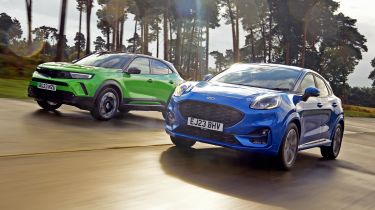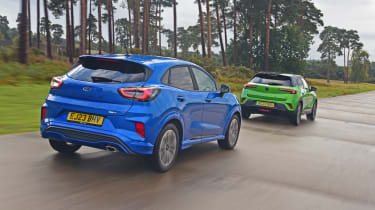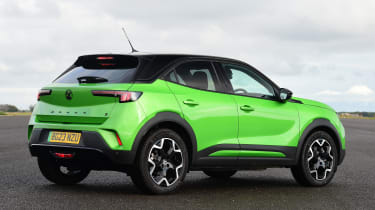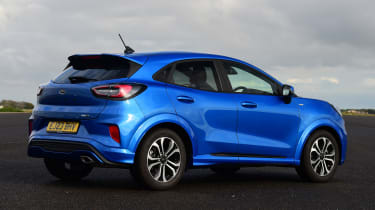Ford Puma vs Vauxhall Mokka: two best-selling crossovers clash
Puma is topping the sales charts, but is it better than the Mokka?
Here we have a face-off of two of the most popular cars in the UK today. Figures from the Society of Motor Manufacturers and Traders (SMMT) show that in 2023 so far, Ford has registered 46,434 Pumas, placing it at the top of the rankings. The Vauxhall Mokka, at 28,290 units, sits in ninth and is the third most common compact SUV, behind the Puma and Nissan Juke. So is that order in the rankings a reflection on their ability?
In certain areas, yes. First and foremost, there’s the way the Puma drives; the chassis has hot-hatch-like reflexes that are backed up by an adjustable balance, plus well weighted and precise steering. Nothing else in this segment will put a smile on your face like the Ford.
The base engine in the range is the 123bhp 1.0-litre EcoBoost, which delivers a 0-62mph time of 9.8 seconds. While this car’s punchy torque output and sweet six-speed gearbox offer keen drivers plenty to enjoy, the pick of the range is the hot ST. It features a 1.5-litre turbocharged petrol engine that pumps out 197bhp – enough for a 6.7-second 0-62mph sprint time – and an even more focused suspension set-up to match. A 168bhp mild-hybrid unit paired with a seven-speed automatic gearbox is a recent addition to the ST family.
There’s clever design inside, too, with the boot a good example. At 456 litres, it’s one of the largest in its class, and is helped by the ‘Megabox’ storage area located below a false floor. The plastic container holds 68 litres and has a drain plug at the bottom so you can wash it out, making it ideal for holding wet or muddy clothes. The load lip is minimal, too, so it’s easy to lift heavy items in and out.
Used - available now

2020 BMW
4 Series
29,690 milesAutomaticPetrol3.0L
Cash £20,501
2023 Ford
Focus
21,621 milesManualPetrol1.0L
Cash £15,998
2023 Audi
e-tron
15,498 milesAutomaticElectric
Cash £23,158
2023 Audi
e-tron
29,621 milesAutomaticElectric
Cash £21,738But the Puma doesn’t have things all its own way. The Mokka’s cabin looks more contemporary, and the neat control layouts are easy to work out. The comfortable seats have lots of adjustment, but as with the Puma, those in the back will feel a little short-changed for space; neither car troubles the class leaders in this area. The Mokka’s 350-litre boot falls short of the Ford’s, but a space-saver spare wheel is available as a dealer-fit option. On the road, the Vauxhall's handling feels a little underwhelming after stepping out of the Puma, but it’s more comfortable and refined than its rival.
Once again, it’s Vauxhall that offers the wider choice of powertrains, including a fully-electric version that promises up to 206 miles of range from a charge of its 50kWh battery. Our choice in the Mokka line-up is further down the range, though. A mid-level GS trim paired with a 134bhp petrol engine and manual gearbox will be more than enough for most buyers.
Vauxhall has once again been very aggressive with the finance deals, offering a whopping £4,100 deposit contribution on this model. Place a further £4,000 of your own down up front, and a PCP finance agreement comes to £293 per month. In contrast, a Ford Puma ST-Line with the 123bhp petrol engine costs £340 on matching terms. That works out costing an extra £1,692 over the course of a three-year deal.
Results
Our choice: Vauxhall Mokka
Ordinarily, the Mokka is a three-and-a-half-star car, but Vauxhall’s huge discounts right now bump up that rating to the point where it’s hard to ignore. If you’re after a stylish and refined compact SUV, then the Mokka is something of a bargain at the moment.
| Pros | Cons |
| Tempting finance rates | Numb handling |
| Refinement | Cramped in the back |
Runner up: Ford Puma
It's clear why the Puma is the UK’s best-selling car. It’s fabulous to drive, has a boot big enough for families and is compact enough to seamlessly slip into anyone’s life. But the Mokka is much cheaper to buy on finance just now, and that’s enough to drop the Ford to second this time.
| Pros | Cons |
| Sharp, engaging handling | Hard ride |
| Huge boot | Limited rear legroom |
Figures
| Vauxhall Mokka Electric Ultimate | Ford Puma ST-Line Edition EcoBoost | |
| On-the-road price | £41,295 | £29,320 |
| Powertrain | 1x e-motor/lithium-ion batt. | 3 cyl in-line/999cc |
| Power/torque | 134/260bhp/Nm | 153/190bhp/Nm |
| Transmission | Single-speed/FWD | 6-spd man/FWD |
| Length/wheelbase | 4,151/2,561mm | 4,382/2,700mm |
| Height/width | 1,531/1,791mm | 1,475/1,825mm |
| Boot capacity (seats up/down) | 310/1,060 litres | 375/1,354 litres |
| Kerbweight/payload/towing weight | 1,598kg/NA/NA | 1,330/565/1,100kg |
| Turning circle/spare wheel | 10.4m/dealer-fit option | 11 metres/space saver |
| Basic warranty/recovery | 3 yrs (60k)/1 yr | 3 yrs (60k)/1 yr |
| Driver Power manufacturer position | 24th | 28th |
| NCAP: Adult/child/ped./assist/stars | 73/75/58/64/4 (2021) | 85/87/72/75/5 (2018) |
| 0-62mph/top speed | 8.7 secs*/93mph | 9.0 secs/119mph |
| WLTP economy/EV range | 201 miles | 44.6mpg |
| Claimed CO2/tax bracket | 0g/km/2% | 123g/km/29% |
| Airbags/Isofix/parking sensors/cam. | Six/two/f&r/yes | Seven/two/r/£500* * |
| Lane keep/blindspot/AEB | Yes/yes/yes | Yes/£950***/yes |
| Climate control/cruise control | Yes/yes | Yes/yes |
| Leather/heated seats/metallic paint | No/yes/£600 | No/£350****/£525 |
| LEDs/keyless entry & go/pwr tailgate | Yes/yes/no | £750/yes/£650 |
| DAB/connected services | Yes/yes | Yes/yes |
| Satellite navigation/digital dash | Yes/yes | Yes/yes |
| Wireless charge/CarPlay/Android Auto | Yes/yes/yes | Yes/yes/yes |










